A place to blog about the pop-culture happenings of the day, and other random musings by Paige Albiniak, TV reporter by day, nerd by night.
Sunday, January 30, 2005
The New York Times explains why I left Hollywood
January 30, 2005
14 Years Later, My Hollywood Ending
By BERNARD WEINRAUB
LOS ANGELES
I CAME to Hollywood in 1991 thinking I knew quite a lot about the world and its ways. As a young reporter, I had been to Vietnam. Later, I covered Northern Ireland, several political campaigns and the White House under President Ronald Reagan and the elder President George Bush. On arriving, I was fresh from a sudden assignment in India after the assassination of former Prime Minister Rajiv Gandhi. But only in my 14 years here - most of it spent covering the movie industry, the rest covering television and music - did I come face to face with some of the more startling, and not always pleasant, truths about human behavior, my own included.
On retiring (officially, this is my final week at The Times), it seems best to sort through this Hollywood tour. It began in a string of modest, even shabby, apartments - one of them, on Martel Avenue in West Hollywood, best remembered for the cluster of police cars, drug dealers and prostitutes on the corner. Along the way I married a studio chief, Amy Pascal, now chairwoman of Sony Pictures. For both of us, the liaison opened a rare two-way window on the inner workings of two worlds, moviedom and the press, that have long been locked in a messy but symbiotic struggle. But our marriage also changed the game. I won't speak for my wife and her own way of coping with career complications born of an alliance with a reporter, but I can say that our wedding, in August 1997, brought to the fore some of my own shortcomings. Clearly, I stayed too long on my beat, clinging to a notion that I could sidestep conflicts of interest by avoiding direct coverage of Sony, and learning too late why wiser heads counsel against even the appearance of conflict. But my marriage, and some of the events that tumbled out of it, also taught me something about the ferocity of a culture in which the players can be best friends one day and savage you the next.
When I finally asked to be taken off the movie beat in 2000, I laughed and said I felt like the Duke of Windsor. But I quickly caught a lesson in how chilly life as a former movie correspondent could be. In the past, I'd written about Jeffrey Katzenberg, then president of the Walt Disney Company. He returned every call quickly and often phoned me; he dished over pasta at Locanda Veneta about all the studios in town and became such a pal that I once showed him off-the-record comments made about him by Michael Eisner. That was wrong and foolish, and years later I still regret it. As soon as I stopped covering movies, Mr. Katzenberg stopped responding to phone calls. I was surprised but shouldn't have been.
Not every Hollywood moment involved operators like Mr. Katzenberg, nor were they all somehow tied up with my marriage. Fellow journalists contributed their share. In one remarkable episode about two years ago, Robert J. Dowling, the publisher and editor in chief of The Hollywood Reporter, threatened to punch me during a charity event. He was upset by an article I had written about two years earlier dealing with staff resignations after his newspaper failed to print an article about an inquiry by the Screen Actors Guild into whether the Reporter columnist George Christy had received pension and health benefits to which he was not entitled. Mr. Christy's column was soon suspended. (Peter Bart, the editor of Variety and a former Times Hollywood correspondent, went beyond Mr. Dowling: he sought to get me removed from the job because of an article I wrote saying that The Hollywood Reporter was catching up with Variety.)
The Hollywood Reporter scandal was, in fairness, pathetic and hardly on the level of Watergate or Iran-contra. And it wasn't akin to the unfortunate way even more serious journalists are co-opted by the overtures of a Michael Ovitz or the charm of a Joe Roth. Mr. Roth, a top Hollywood player, seems available at any time and is willing to schmooze with eager reporters as if he had all the time in the world.
Mr. Ovitz went a step or two further. Shortly after I arrived in Hollywood and met him, when he was at his zenith as chairman of the Creative Artists Agency, he offered to help if my children needed to attend private school or if I needed to find a hospital. I never took him up on the offers.
MY first day here, as I recall it, was in early September 1991. Having just come back from India, I was struck almost immediately by the prevalence of money, and the crazy economic gap between journalists and the people they covered. It was like dropping into Marie Antoinette's France. In Washington, reporters often lived next door to the people they covered. Whatever the income gap between a reporter and a lawyer or lobbyist - and it's considerable - your lives intersected. In the neighborhood. On the subway. At private schools. At parties.
Journalists in Washington do not feel diminished by their lower salaries. In Hollywood, many do. I did. Waiting for a valet at the Bel-Air Hotel to bring my company-leased Ford, I once stood beside a journalist turned producer who said, "I used to drive a car like that." Though I'm ashamed to say it, I was soon hunting for parking spots near Orso or the Peninsula Hotel to avoid the discomfort of having a valet drive up my leased two-year-old Buick in front of some luncheon companion with a Mercedes.
For many of us on the press side, the money gap leads to resentment and envy, compounded by a conviction that studio executives and producers are no better or smarter than the journalists who cover them. Initially, I was simply amazed. My first real Hollywood acquaintance was Dawn Steel, a producer and onetime studio chief, and one of the more dynamic figures in town. (Ms. Steel died of a malignant brain tumor in 1997 at the age of 51). Before leaving New York, I was in the office of Warren Hoge, then the editor of the Times Magazine, who said Ms. Steel would open the gates of the movie world for me. He called her on her car cellphone, which was still uncommon enough that I was dazzled. She insisted that I see her as soon as I arrived. I did so. Her house off Coldwater Canyon, behind gates and atop a winding road, was a sprawling, ranch-style home with panoramic views of the city on a huge plot of land. I had never seen a home like this.
What made it strange was that Ms. Steel was a girl from Long Island - smart, funny, neurotic. She had no airs. She and so many others in Hollywood seemed like people I knew. I grew up with them. And yet they earned bizarre amounts of money that lifted them into a different universe.
My first reaction was to write about that difference. Early on, for instance, I wrote about movie stars and executives trooping into a specially designed soundstage at Sony for the Hollywood Hunger project to benefit Oxfam America. Instead of simply writing checks, the celebrities sought what the caterer, Ruth Hedges, told me was "the actual experience of being poor and hungry."
So the likes of Danny Glover, Jackson Browne, Daryl Hannah, Whoopi Goldberg, Susan Sarandon, David Byrne and Graham Nash drew lots: 15 percent represented high-income countries and dined at fancy tables on stuffed breast of chicken, sun-dried tomatoes and radicchio, and salad with shrimp; 25 percent represented middle-income countries and sat on benches at wooden tables to eat rice and beans and tortillas off paper plates; and the majority, sat on the floor on a mat and had rice and water, as many people in the world do.
Almost as shocking (at least for me) were the gala events to raise money for ecological causes in the early 1990's. At one such event, 700 of the town's elite (Barbra Streisand, Robert Redford, Ted Danson, Jane Fonda) showed up at a soundstage in Mercedeses, BMW's, stretch limos and other gas guzzlers to celebrate Hollywood's commitment to the environment. The invitations said, "In the spirit of the event, we urge you to car-pool." It didn't appear that anyone did.
Detachment from the real, I soon learned, was closely bound up in the culture of stardom, and star behavior, alas, has a way of rubbing off on those of us who come in contact. At first, as I now hate to admit, I was fascinated by the idea of meeting movie stars. (After meeting a few, the fascination ended.) Maureen Dowd in Washington made me promise I'd interview Michelle Pfeiffer soon after arriving. As it turned out, she was my first star interview. She was promoting the film "Frankie and Johnny," in which, bizarrely, she was playing a frumpy waitress.
I met Ms. Pfeiffer at her office in Century City. I was tongue-tied. She talked about her character's loneliness and how she identified with the waitress. I nodded at whatever Ms. Pfeiffer said. She told me it was a fantasy that beautiful people couldn't look unattractive or weren't lonely or hurt. "It doesn't matter what you look like or how old you are," she said. "That's not relevant." Right. For a moment, I believed it.
At another point, at the Toronto Film Festival, I rushed through an interview with Billy Bob Thornton and Bill Paxton about their film "A Simple Plan." It was important for the two actors to promote their offbeat film and get an article in The Times. I cut short the interview and said, "Look, I've got to interview Cameron Diaz." The pair were dumbfounded. She was prettier and a rising star. She was more important. The fact that I had hurt the actors and embarrassed myself still rankles. Not a high point but perhaps the beginning of real understanding about a world that obsessively chases what's young, what's new, what has heat.
My most embarrassing moment in Hollywood was an interview with Jim Carrey that at least absolved me of star fever. The comedian, in a suite at Ma Maison Sofitel, was promoting his film "The Mask." I had taken medicine for a bad cold. The interview began. I was settled into an easy chair, facing Mr. Carrey with my feet crossed in front of me. As he began answering questions, I fell asleep. The next thing I knew, I was feeling somebody kick the bottom of my shoe with his foot. I woke up, mortified. Years later, I met his manager Jimmy Miller. I told Mr. Miller I had a confession: that I fell asleep while interviewing Mr. Carrey. Mr. Miller exclaimed: "So you're the guy! He talks all the time about a reporter who once fell asleep on him."
IN 1996, I met Amy Pascal for a business breakfast at the Peninsula Hotel. She had just been named president of Turner Pictures, a new company founded by Ted Turner.
Not even 18 months later, the company was folded into Time Warner.
As we began dating, I rationalized that I could avoid any hint of a conflict of interest by avoiding any coverage of Turner Pictures. By the time we were married, the next year, my wife had been appointed chairman of Columbia Pictures. I should have left the movie beat right then, if not sooner.
But with the agreement of my editors, who were confident I could deal with the issue, I felt I could continue covering the movie business, avoiding coverage of Columbia and its parent company, Sony, and leaving that to a colleague. It was a delicate balancing act that seemed to work for a while. But I underestimated how closely I would be watched, or how quickly Hollywood would jump on my marriage as way to get an edge in coverage by The New York Times.
Warner Brothers, once a high-flying studio, was at that time beset by a string of expensive movie flops and its parent company's music operation had a weak track record. With a colleague, Geraldine Fabrikant, I covered the failures at Warner, whose co-chairmen were Robert A. Daly and Terry S. Semel. The two eventually resigned.
Mr. Daly was furious and told friends and others that I should not write such articles because of my marriage, a view I came to share, though I remain convinced that the coverage was accurate and fair. Soon enough, an article appeared in Brill's Content, a magazine covering the news media, by Lorne Manly (now a reporter for The Times). It said that "two Hollywood sources" said Warner had offered my wife a production deal instead of "the high-ranking job she sought," and that "instead she headed to Sony." As I read it, the implication was that The Times's articles were written because I was personally peeved at Warner and not because the studio was experiencing failures like "The Postman" and "Sphere."
I wrote to Bill Kovach, the ombudsman for Brill's Content and a former Times Washington bureau chief for whom I had once worked, to complain about what I called the cheap and inept journalism at his magazine, which was itself financed by Barry Diller, George Soros and others. Would the magazine ever write about Mr. Diller or Mr. Soros? I asked in an angry note. Mr. Kovach responded with equal anger. In retrospect, the nastiness of journalists toward The New York Times - and me - should have been a warning that this was a losing battle.
Mr. Ovitz, who began complaining to The Times about my coverage shortly after I arrived, was soon trying to use my marriage as a lever to oust me. He visited The Times after I had written about his troubled management company, which he formed after his dismissal from the Walt Disney Company. At the time Mr. Ovitz was also facing problems because of a failed Broadway investment and a vain effort to start a football franchise.
"What does The New York Times have against me? Mr. Ovitz asked Joseph Lelyveld, then the executive editor, according to New York magazine. "Your football writer hates me, your theater writer hates me and Bernie Weinraub just killed me."
Mr. Lelyveld said: "What are you talking about? If I got all three writers in a room they wouldn't even know each other."
True.
In a later phone conversation, Mr. Ovitz urged The Times to dismiss me and finally shrieked at Mr. Lelyveld: "You don't know anything about our business! I can't talk to you!"
In mid-1999, Mr. Lelyveld came to Los Angeles. I began our lunch by saying that I wanted off the movie beat. Not because I was tired of it, but because it was being used as an excuse to attack me and the newspaper I loved. Mr. Lelyveld was visibly relieved. I had saved him from saying it was getting difficult for the newspaper. I asked about covering television and other entertainment. He agreed.
IN December 2001, less than three years later, I received a call from Julia Phillips, the once-hot producer of films like "Taxi Driver" and "Close Encounters of the Third Kind," who had drifted from center stage in Hollywood long before she wrote her classic tell-all, "You'll Never Eat Lunch in This Town Again." To my regret, I asked her to hold on one minute while I finished on another line. As soon as I returned, Ms. Phillips said: "I'm dying. And I want an obituary in The New York Times."
Shortly after arriving in Hollywood, I had met Ms. Phillips late one chilly afternoon at the Polo Lounge at the Beverly Hills Hotel. I wanted to write about her as the author of a slash-and-burn chronicle that detailed the selfishness, duplicity, nastiness and greed of the Hollywood stars and executives she knew in the 1970's and 1980's. The book also revealed her own plunge into cocaine addiction.
Ms. Phillips said she was a pariah in town. "I saw these people for what they were," she said. In the years that followed I became friendly with her: she would call me periodically to either congratulate me on an article or criticize me, saying I was naïve or had been duped. At dinner at Orso, her favorite restaurant, she was brutally honest about herself and about the Hollywood crowd. "Don't trust these people," she warned me numerous times. "Don't trust anyone here."
I laughed and didn't really believe her. But with time I came to realize that she, more than Dawn Steel, had become my most reliable guide to the ways of what insiders still like to call "the town."
Responding to her call, I immediately drove to see her in her apartment looking out onto West Hollywood and, on a clear day, downtown. I said I wanted to tape-record some interviews for an obituary. And I asked if she wanted anything else. Ms. Phillips said she adored George Clooney and would love to see his latest film, "Ocean's Eleven." (Warner Brothers, which had tapes of the film, sent her a copy the next day.) I spent several days visiting and interviewing her.
Because of her book, Ms. Phillips was an outcast among Hollywood's elite. "At first it bothered me because I really didn't expect that kind of reaction," she said. "I thought people had a sense of humor. I really did.
"Understand, I wasn't a pariah because I was a drug-addicted, alcoholic, rotten person and not a good mother," she said. "I was a pariah because I lit them with a harsh fluorescent light and rendered them as contemptible as they really are."
Ms. Phillips died of cancer in the early days of 2002. I went to her funeral service on the rooftop of her apartment building and thought of what she said while dying. Was it an overstatement? I wonder. I'm part of the Hollywood world now. I can't deny it. I drive a Range Rover. I live in Brentwood. Not everyone is contemptible. Perhaps Julia Phillips was wrong. I hope she is.
If you can't brag on your own blog, then where can you?

Is Simon's head superimposed in this picture? It looks too big to be real. Or not.

Here's a link to the NY Post's TV Week, where I sold a story this week. My story, with my byline and everything, is right on the cover!
A friend in LA said to me: "isn't the rule that if you get three stories in the New York Post, you get to write for the New Yorker?" I said "no, I think the rule is that if you get one story in the New York Post, you are forever forbidden from writing for The New Yorker."
So don't look for me there.
Friday, January 28, 2005
Buster's friend has two mommies

Buster visits Wind River, Wyoming


Buster goes rock-climbing in Boulder

In case you were wondering whether the Bush Administration actually is an evil cabal of would-be dictators who are pretty sure that they know how everyone else should live, the following article should clear that up.
Written by the hilarious Lisa de Moraes, TV columnist for the Washington Post, the article discusses how PBS, in its all-too-familiar role as eternal political punching bag, caved completely to the Education Department (aka Bush Administration’s czar in charge of how schools should be run even most of the government’s money is going to Iraq).
DOE recently became aware that in one episode of PBS’ Postcards from Buster, the animated bunny visited real-life families in Vermont and learned, shock of all shocks, that two of his new friends had two mommies. The episode wasn’t really about that—it was about how to make maple syrup and cheese and how to speak English—but the two mommies were present and visible. In response to pressure from the Administration (a constant refrain of ‘if you don’t behave yourselves and portray the country in the way we want you to we will pull your funding’), PBS disintegrated like a wet cardboard box and decided not to distribute the episode.
This is not new behavior from PBS. And I have to say I don’t blame them, even though I do think they are pretty much a bunch of lily-livered cowards (what exactly is a ‘lily liver’? Does anyone out there know? And does lily have one L or two?).
The service gets only about 10% of its funding from the government – aka taxpayers. That’s not so much, but it gets the remainder of its money from corporate sponsorships and public fundraising. Constantly accused of having a strong liberal bent, PBS proves Republicans correct when it pulls stunts such as admitting that there are gay people in America. It also faces constant criticism from TV writers and other media watchers who gripe any time anything like a commercial shows up on PBS’ air. That means that if a voice-over comes on after a show saying “this presentation of Nova sponsored by Juicy Juice,” someone has a problem with it.
So, with Republicans looking for any opportunity to kowtow to conservative constituents and liberals watching closely for creeping commercialism, that doesn’t leave PBS with many places left to go to get its money. They end up having to kowtow to someone just so they can keep funding themselves.
According to what I infer from DOE’s objections to the Buster episode, this type of information could be damaging to pre-schoolers’ fragile brains. According to what I infer from preschoolers that I know, they could care less. Preschoolers don’t know that two women or two men or a black man and a white woman or an alcoholic and an enabler aren’t supposed to meet and mate. They just see kids and parents, fun or no fun, love or no love. It’s when the adults, with their closed minds and absolute certainty that things are supposed to be a certain way, get involved that things get complicated.
Of course, I am bringing my own closed mind to this debate, as I am demonstrating by writing this. My closed mind believes that it’s no one else’s business if two women or two men want to have babies. If you are opposed to that or if that disgusts you, that’s your business. What I don’t understand is why people feel so obligated to impose themselves and their way of thinking on others.
With regard to TV programs and kids, I always make two points: 1) there’s an off button and 2) there’s a First Amendment. That means that in this free country of ours most material—other than that which can be proven patently offensive, and that’s not much—should be free to be consumed. It also means that if you have chosen to be a parent, that requires parenting. And parenting requires monitoring a child’s TV watching.
For every parent that’s opposed to kids knowing that some people are gay, there are other parents who are all for it. Why should the pro-gay constituency be penalized by the anti-gay one? Why can’t the anti-gay constituency just change the channel? That's what we liberals do when we accidentally come upon Fox News.
Now, granted, it’s a lot to ask for parents to know the content of every PBS program and episode before their child sits down to watch it. And parents need to have channels where they feel safe letting their children hang out.
But it seems to me that this could be quickly handled by distributing episode information for TV guides ahead of time, and also issuing a warning statement prior to and maybe inside of the program. Even that seems a little Draconian to me, but in fairness, I don’t think parents should be ambushed by potentially objectionable content.
While I think that all the hullaballoo about Janet Jackson’s stupid breast is the most overwraught, pointless, useless debate practically in American history, I also think that Janet and Justin and whatever producers knew about the stunt ahead of time (and whatever they say, at least the two performers knew good and well what they planned to do), and that their 'impromptu' performance took away millions and millions of parents’ right to choose what their children see. That’s where the huge mistake was made. I wonder if Janet and Justin would make the decision again if they knew ahead of time that exposing her breast would threaten our freedom. And I don't think I'm being overly dramatic when I say that, given the debate and censorship that has taken place in this post-Janet world.
I believe people should be given information that allows them to make a choice. What I definitely don’t believe, and the constitution backs me up on this, is that material should be censored just because the party in power objects to it.
PBS's 'Buster' Gets An Education
By Lisa de Moraes
Washington Post
Thursday, January 27, 2005; Page C01
PBS was surprised to receive a letter from new Education Secretary Margaret Spellings, warning the public TV network against airing an upcoming episode of the kids show "Postcards From Buster," because PBS had already informed her office it would not send the episode to its stations, programming co-chief John Wilson says.
"We made the decision . . . [Tuesday] afternoon, a couple of hours before we received the letter from the secretary of education," Wilson told The TV Column yesterday.
"It came at the end of many days, maybe even a few weeks, of looking at rough cuts of the program and deliberating."
Spellings, who has been charged with the difficult task of fixing the nation's troubled public education system, took time out on her second day on the job to fire off a letter to PBS CEO Pat Mitchell expressing "strong and very serious concerns" about the "Postcards From Buster" episode. Specifically that, in the episode, called "Sugartime!," the animated asthmatic little bunny visits Vermont and meets actual, real-live, not make-believe children there who have gay parents.
For those of you unfamiliar with the spinoff of the popular children's series "Arthur," which combines animation and live action, each week, 8-year-old animated Buster and his animated dad travel to another locale, where Buster, armed with his video camera, meets actual, non-animated people, who introduce him to the local scene -- clogging in Whitesburg, Ky.; rodeo barrel racing in Houston; monoskiing in Park City, Utah; doing the Arapaho Grass Dance at the Wind River Reservation in Wyoming. Additionally, Buster meets a family from a different cultural background.
In the episode that knotted Spellings's knickers, Buster goes to Vermont and meets children from two families, who show him how maple syrup and cheese are made.
At one of the homes, Buster is introduced to all of the children and to the two moms. One girl explains that one of the women is her "stepmom," whom she says she loves a lot.
One of the women asks the kids to get some maple syrup and some cheese for dinner, and to stop by the other home to borrow a big lasagna pan. In the other home, Buster is introduced to the whole family, including two more moms. Then the kids head off to get the ingredients, and Buster learns where syrup and cheese come from.
In her letter, Spellings reminded Mitchell that the show is being funded in part by the Education Department and that a principal focus of the law authorizing such "Ready-to-Learn" programming is "facilitating student academic achievement."
In the conference committee report for fiscal year 2005 appropriations, Spellings continues, Congress reiterated that the unique mission of Ready-to-Learn is: "to use the television medium to help prepare preschool age children for school. The television programs that must fulfill this mission are to be specifically designed for this purpose, with the highest attention to production quality and validity of research-based educational objectives, content and materials."
"You should also know," Spellings says, "that two years ago the Senate Appropriations Committee raised questions about the accountability of funds appropriated for Ready-To-Learn programs." A bit ominous, we think.
"We believe the 'Sugartime!' episode does not come within these purposes or within the intent of Congress and would undermine the overall objective of the Ready-To-Learn program -- to produce programming that reaches as many children and families as possible," Spellings wrote.
Why, you might wonder, given that preschoolers who watch the episode learn how maple syrup and cheese are made, not to mention useful English-language phrases (the series is also designed to help children for whom English is a second language).
Because, Spellings explained in her letter, "many parents would not want their young children exposed to the life-styles portrayed in this episode." She did not say how many is "many," or cite a source for that information.
Congress's point in funding this programming "certainly was not to introduce this kind of subject matter to children," she added.
Au contraire, says WGBH, which produces "Postcards." The Boston public TV station says it will air the episode and has offered it to any station willing to defy the Education Department, which, in fairness, did shovel out major bucks for this series and, therefore, understandably feels it has the right to get in its two conservative cents' worth.
According to Brigid Sullivan, WGBH's vice president of children's programming, the RFP -- that's government-speak for request for proposals -- on the show said Ready-to-Learn was looking for a program that would "appeal to all of America's children by providing them with content and or characters with which they can identify. Diversity will be incorporated into the fabric of the series to help children understand and respect differences and learn to live in a multicultural society. The series will avoid stereotypical images of all kinds and show modern multi-ethnic/lingual/cultural families and children."
Except, it would seem, children who have two mothers.
"We have produced 40 episodes," Sullivan said. "We have tried to reach across as many cultures, as many religions, as many family structures as we can. We gave it our best-faith effort. We have received hate mail for doing [an episode] about a Muslim girl. We've also received mail from Muslims saying thank you."
Buster, Sullivan said, has visited "Mormons in Utah, the Hmong in Wisconsin, the Gullah culture in South Carolina, Orthodox Jewish families, a Pentecostal Christian family -- we are trying to do a broad reach and we are trying to do it without judgment."
According to Sullivan, the "Buster" brouhaha started in December when, during a routine meeting of representatives from WGBH, PBS and the Education Department to discuss upcoming episodes, a WGBH rep mentioned that there might be some "buzz" on "Sugartime!" PBS insists that although it made its decision not to distribute the episode on the very same day that the newly appointed Spellings decided to fire off her letter, the decision had nothing to do with the kerfuffle brewing at Education over the episode.
Which, we've said before in similar situations, sounds great if you were born yesterday; otherwise, not so much.
"Ultimately we came to the conclusion that what was meant to be the background or backdrop of two families that happened to be headed by two mothers continued to find its way into the foreground," Wilson said.
"It's too sensitive to raise in a children's program," he added. "We know we have a number of kids . . . who don't have a parent or caregiver in with them watching to put it in context. At the end of the day what was meant to be a sort of background context of who this family is and who the parents are, overshadowed what the episode was really about, which was going to this part of America and learning about things that are uniquely Vermont.
"Yesterday afternoon we literally decided that it was an issue best left for parents and children to address together at a time and manner of their own choosing."
We asked all parties involved what they would say to the children who were filmed for this episode, and who expected to be seen on national TV and are now being told by the federal government that their families are not fit for other children to see on national TV -- at least not on any show that has received federal funding.
"That's a difficult question," Sullivan responded. "I guess I'd have to say from the producers' standing . . . it was our intention to include, not to exclude, anyone who is part of our society, and that for children to see a reflection of themselves on TV is an important part of their development."
"I've been thinking about that today," Wilson said. "Honestly, I feel for these families because they're real people, not actors cast and paid to do this, and I do feel bad that through no fault of their own and ultimately no fault of the producers they have been put in a situation they never imagined themselves in. To that end, I'm sorry for that."
An Education Department spokeswoman responded in a statement: "The episode is inappropriate for preschoolers. We are funding an education program for preschoolers, and one would be hard-pressed to explain how this serves as educational material for preschoolers. It's up to parents to decide for their children, not the government in a taxpayer-funded video for preschoolers."
We asked her to clarify what it was the department felt should be left to parents. She explained: "To decide when they want their kids to know about the lifestyles depicted in the film."
Tuesday, January 25, 2005
The Passion of the Right Wing
Today, two interesting things happened.
The Passion of the Christ, to the surprise of no one who follows these things, was not nominated Best Picture of the Year.
And Ted Turner compared the popularity of Fox News Channel to the early popularity of Hitler.
So we see the country’s dividing lines pretty clearly.
On the right we have: Jesus and Hitler.
And on the left we have: Ted Turner and film critics.
Who knew things would fall out that way?
While I am not among those that believe The Passion of the Christ should be considered Best Picture of the Year just because it’s about Jesus, I have to admit a few things. First, it made more money than almost any other movie this year (ok, the third-most, according to CNN). Second, film critics and others among the Academy’s voting elite tend to be liberal, erudite and not religious. So I can’t deny that possibly some bias kept the Passion off the best-picture lists. Finally, I didn’t see the film (see comments below re: The Pianist) because I couldn’t rally myself to watch a two-plus-hour movie in Aramaic about someone getting beaten, tortured and ultimately killed. That is the way the story goes, and I’ve heard it plenty of times, but I didn’t feel like I needed to experience it in the movie theatre when I’ve experienced it in church all these years.
As for Ted Turner’s comments at the National Association of Television Program Executives in Las Vegas today: are we surprised? Ted Turner is always saying such things. What surprises me is that the outrageous comments of a washed-up media mogul continue to make news. But I’m writing about them, so I guess I have to take some responsibility too.
Here’s the thing. Just because a movie is about Jesus doesn’t mean it’s the Best Picture. Just because George Bush calls himself a Christian doesn’t mean we all need to vote for him. Just because Fox News is popular among the country’s redneck Republicans doesn’t mean its Hitleresque in stature. And just because film critics think that Closer is a good movie doesn’t mean that it is.
A little perspective, people.
It's Oscar Time
I admit I have an unnatural enthusiasm for the Oscars. I don’t know why. I don’t feel the same way about any other awards show. The Grammys – out of touch and random categories. The Golden Globes – who cares what a bunch of foreign journalists think? The Emmys – the spoils go to the established so the voters don’t have to seek out any new television. The People’s Choice Awards – what do the people know? But for some reason, I have always loved the Oscars. In fact, it still annoys me that they moved Oscar season up a month (to put the high-rated show right at the end of February sweeps). It gives me less time to see the movies.
This year, I have already seen quite a few. After my stint in Hollywood, I learned that if you follow all these critics’ awards, by the time Oscar rolls around you pretty much know who is getting nominated. This year, I’ve already seen four out of five of the best picture nods (still need to see Million Dollar Baby). What I love about the Oscars is that it forces me to see movies I would never get myself into the theatre to see. I have to admit I still haven’t managed to make myself watch The Pianist, for which Adrien Brody became the youngest Best Actor winner ever, even after my Netflix DVD of it sat on my TV for something like five months. This year, my “I know I should” movie is Hotel Rwanda. Don Cheadle is a brilliant actor, and I’ve thought so since Traffic, but the topic is tough. That’s probably why I should see it.
One of the tragic things about moving away from Los Angeles is that I probably won’t have the opportunity to see all the nominated foreign films, documentaries and short films. Those get airings in LA (and DC) but most of the folks in Colorado are more interested in climbing the nearest mountain and skiing down it than going to the movies.
But enough of that. Since I have a blog this year, I’m going to go out on a limb and predict the winners of the major categories. Normally this is an activity I save for Oscar night, when I work hard to win the pool.
Leading Actor: As we already know, I believe Jamie Foxx is a lock to win this. Paul Giametti didn’t even land a nomination! And Kinsey, starring Liam Neeson, is scarcely on the nomination list, except for Laura Linney’s nod in the supporting actress category. I guess that’s a movie I don’t have to see, which is a good thing because it’s not here anymore.
Supporting Actor: Thomas Haden Church for Sideways. Why not? He’s won everything else. And it’s rare for an actor to be nominated twice (Foxx in Ray and Collateral). It’s unprecedented for him to win twice. Finally, if Closer (Clive Owen) wins anything, I’m going to throw up. No matter how very hot Clive is. (My vote for the next James Bond, by the way, although no one listens to me on such matters.)
Leading Actress: Hilary Swank for Million Dollar Baby. The actress once again transformed herself into another person, going so far as to drink glasses of egg whites in the middle of the night to help put on 25 pounds of muscle. This Oscar will confirm Swank as one of Hollywood’s top Actresses, not just a one-time winner.
Supporting Actress: Cate Blanchett for The Aviator, although she will have heated competition from Virginia Madsen for Sideways. Madsen has been the critical darling this year, but Blanchett is overdue and the Academy loves her. What’s more, Blanchett is a major leading lady and Madsen is scarcely known. Still, I’d give both actresses 50-50 odds. Natalie Portman is too young and she’s got a long career ahead of her, plus did I mention how much I hated Closer?
Directing: Martin Scorsese for The Aviator. Scorsese’s sweeping biopic about a subject that terrifies him is the most-nominated film this year. And, as mentioned before, Scorsese is probably the most overdue person in Hollywood. He probably should have won for Gangs of New York, but competition was tougher that year.
Adapted Screenplay: The most awarded film of the year got there because of a beautifully written script. Sideways should win this tightly-contested category.
Original Screenplay: If there is an Oscar god, Eternal Sunshine of the Spotless Mind will win this category. Was there any movie more original last year?
And finally, Best Picture: With 11 nominations, The Aviator is likely to win this one. No other movie nominated this year is as broad in scope or as commercially viable. Ray is largely a one-man show; Finding Neverland, while delightful and whimsical, doesn’t showcase big enough performances; Sideways is too small and intimate; and not enough people have seen Million Dollar Baby.
As a postscript, here’s what I want to know? Where is House of Flying Daggers in the Best Foreign Language Film category? That gorgeous movie deserved to be nominated.
Wednesday, January 12, 2005
Sideways

the cast of Sideways

Note to Steven Soderbergh and George Clooney: Critically-lauded Sideways is a textbook example of how a movie can feel natural and effortless and still be guided by a great script and a great director.
In the movie, oenophile (I’m proud to say I got this word right on the first try!) Miles (American Splendor’s Paul Giametti) and aging actor Jack (Wings’ Thomas Haden Church playing a character whose life story mirrors his own) travel to Santa Barbara wine country to celebrate for one last week before Jack gets married. Along the way, they meet two women—Virginia Madsen’s wine-loving and luminous Maya and Sandra Oh’s exuberant wine-pourer Stephanie—and two affairs ensue. Threaded through the story is a study of two immature and dysfunctional men as they go about lives they can't stop messing up.
The acting in Sidewaysis so seamless that the audience doesn’t even know it’s happening. That’s why Church and Madsen are cleaning up all the critics’ awards thus far this year. And while his performance clearly was this critically-adored film’s heart and soul, Giametti is once again the victim of bad timing. He has no choice but to sit on the sidelines and watch Church and Madsen sweep up the accolades because Jamie Foxx has no peer this year. But without Giametti at the center—playing the sad-sack role he was born to—the movie wouldn’t have been the same.
After seeing Sideways, my sister Ashley noted that the mark of a great director is no sign whatsoever that he’s been there.
Counter-examples that prove that theory are Soderbergh’s focus-free Ocean’s 12 or disasterously boring K Street, a failed unscripted, unplanned series on HBO which featured real-life, not-too-attractive political consultants James Carville and Mary Matalin talking on their cell phones in the back of DC cabs while running from meeting to meeting. Both projects demonstrate that even visionary directors like Soderbergh--who unfortunately has fallen in love with this free-form filmmaking--benefit from a tight script, a carefully constructed plot and meticulous planning. Reality TV is fun and all, but even Survivor has writers. Alexander Payne’s quiet ensemble dramedy takes advantage of all those things. That allows Payne to turn a small, intimate piece into a legitimate contender for this year’s best picture Oscar.
No question, Miles and Jack are not honorable characters. At about the film’s halfway point, I was pretty sure that if I had been on such a trip with either of these people, I would have packed up and bailed on about day two, never to return a phone call from either of them ever again.
But Payne surrounds these two with women who make watching the disasterous pair more than tolerable, and even enjoyable. The dynamic between the group of four gives this film depth and warmth that Mike Nichols’ Closer, also a film full of unredeemable characters, lacks. We see growth, albeit miniscule, in both men, and more importantly, they reveal their vulnerability and insecurity to each other and to us. In Closer, Clive Owen has a marvelous breakdown at the strip club where Natalie Portman works, but that’s about it in terms of revealing moments.
My friend Tina said she didn’t think she was old enough to fully relate to Sideways. I don’t think I’m alcoholic enough to fully relate to it. The film is a lush portrait of Santa Barbara’s gorgeous wine country where Mom and I have twice enjoyed wonderful trips. But we drank far far far less than our hapless heroes, due not only to lack of desire but sheer physical impossibility. During the movie, I pondered whether I really really wanted a glass of wine or if I never wanted to drink again.
Still, I don’t think this movie is as much about age as it is about failure and fear, and somehow forcing yourself to take just that one little step that lets you climb out of all that.
As I said in my previous blog about Ray Charles and Howard Hughes, Payne likes to explore the life of the little guy: Matthew Broderick’s flailing high-school teacher in Election, Jack Nicholson’s doddering retiree in About Schmidt, and now Jack and Miles, two men no one should date, much less marry.
Still, through careful crafting, Payne comes much closer to showing us real life than any director out there I can think of. And his biggest trick is this: we love watching it.
Letterman strikes again
Top Ten Proposed Changes At CBS News
10. Stories must be corroborated by at least two really strong hunches.
9. "Evening News" pre-show staff cocktail hour is cancelled until further notice.
8. Reduce "60 Minutes" to more manageable 15-20 minutes.
7. Change division name from "CBS News" to "CBS News-ish"
6. If anchor says anything inaccurate, earpiece delivers an electric shock.
5. Conclude each story with comical "Boing" sound effect.
4. Instead of boring Middle East reports, more powerball drawings.
3. To play it safe, every "exclusive" story will be about how tasty pecan pie is.
2. Not sure how, but make CBS News more like "C.S.I."
1. Use beer, cash and hookers to lure Tom Brokaw out of retirement.
Sunday, January 02, 2005
Howard and Ray

Leonardo DiCaprio as Howard Hughes in The Aviator


Jamie Foxx as Ray Charles in Ray

I feel a little weird blogging about movies when the statistics from Southeast Asia keep getting more mind-boggling by the minute, but since I’ve been going to the movies during the holidays while relief workers bring in food and supplies and bury bodies, I guess that’s what I’ll write about.
Ray and The Aviator – probably the two movies with the most collective Oscar buzz between them – offer the life stories of two talented, charismatic geniuses who tend toward self-destruction. Both stories illustrate the notion that burning too bright often comes with a heavy price, that genius and madness are frequently two sides of the same coin. Neither address the opposite question, the one that most of us deal with: is the price of a more careful life, the one that most of us live, a long, slow, uneventful ramble toward death and anonymity? And which is preferable?
I’m tempted to say that movies usually don’t deal with the quieter of these two inquiries, but occasionally they do. Alexander Payne’s About Schmidt tackled it – what does the end of a quiet, risk-free life look like? Feel like? Is it satisfying? But usually, the common folk aren’t interested in watching their own forms and foibles wander across the screen, they have enough of that every day. It takes big risk-taking, big gambles, to warrant an entire feature film about a life.
And both Howard Hughes and Ray Charles were big risk-takers, each of the sort that American society worships. Nevermind the costs: Hughes ultimately paid in madness, drug dependency and complete social ostracization; Charles in heroin addiction. One was overrun by his demons, the other ultimately redeemed himself, but to some extent, the stories run on parallel tracks. While both men faced the world’s challenges head-on, at the end of the day they each seemed not to have enough left within them to handle the trivialities of their lives. Hughes escaped into mental disorder masquerading as order and control; Charles escaped into women he didn’t love and a drug that clouded his exuberant and musical mind.
In one interview, Aviator star and self-made Hughes expert Leonardo DiCaprio says that when Hughes crashed a test flight into Beverly Hills apartment homes, it was like Icarus flying too close to the sun. Hughes never really brought himself all the way back after that one, and the injuries he sustained in that catastrophic wreck eventually led him to become addicted to painkillers, an issue the movie, chronicling the younger man, doesn’t address.
Ray Charles also had his Icarus moments, flying high, crashing low. He went from churning out number-one hits and negotiating for himself the most lucrative record contract the industry had yet seen to getting busted for heroin possession and eventually having to wean himself off the evil substance, a process that in itself should deter anyone from trying that drug.
Maybe such big personalities require huge counter-measures to balance them out. While the average 9-to-5er can smooth out the edges with a glass or two of wine at the end of the work day, maybe it takes much more to settle these types down.
And maybe it’s a requirement that such folk be forged from difficult circumstances. Hughes, although he inherited a fortune, was an orphan by the age of 17 and an only child. His mother, as portrayed in the movie, was overprotective and overintimate. Charles was the son of a poor but strong single mother, and he watched his little brother drown in an accident when he was 7, an incident that haunted him throughout the rest of his life. Soon after, glaucoma took his eyesight, leading him to discover his other gifts.
Without the risks these men took, there’s much that society would be without. Hughes helped pioneer commerical transatlantic flight and jet air travel, while Charles gave us an entirely new form of music, fought successfully against segregation and proved one more time that all races are created equal.
Perhaps we get some solace from sitting in a dark theatre observing the lives of people who beat down such adversity and go on to live so largely – see, we can say, if we live likewise we too will face madness or drug addiction, disasterous marriages or no marriages at all. If we take no chances, at least we won’t pay big prices.
But maybe it’s the combination of all of the above factors that led Hughes and Charles to seem so fearless and take such big chances. They placed big bets because they felt they had nothing to lose, and it was just those bets that made them feel like they had any place on this earth at all. Both men seemed fearless on the outside, while demons gnawed at them from within. Hughes was engulfed, while Charles fought past his scratching and clawing. It’s not lack of fear that defines courage, it’s the willingness to face that fear and proceed anyway.
Both movies also embrace some fearlessness: Martin Scorsese has such a fear of flying that the title alone of The Aviator nearly dissuaded him from doing the movie; Leonardo DiCaprio has dreamed for ten years of bringing Howard Hughes to the silver screen, with himself in the title role, making a potential public failure that much more intolerable; and Jamie Foxx took on a beloved icon and inhabited the man so completely that there’s no sign left of Foxx.
Since it’s but two months away, let’s address my favorite awards show of the year, the Oscars. The Aviator could win the Oscar for best movie, but Scorsese has a better chance of walking away with Best Director because he thoroughly deserves it, and Oscar often awards statues to greater artists in lesser projects if they’ve been overlooked in the past. (See Denzel Washington and Russell Crowe). Scorsese is probably the most overlooked, legendary director working today. (Quentin Tarantino would be another one, but he’ll get his soon enough.) DiCaprio will be nominated but won’t win, but Cate Blanchett, playing Katherine Hepburn, will achieve both.
As for Best Actor, Jamie Foxx’s time has clearly come. No other performance this year even comes close. What Foxx does in Ray is closer to channelling than acting.
As I said, I’ve seen a lot of movies over the break, so besides the above-mentioned picks, here are a few more. Both Johnny Depp and Kate Winslet will be nominated for Finding Neverland, which also should be nominated best picture. Winslet also has a shot at a nomination for Eternal Sunshine of the Spotless Mind, which also will likely win Best Original Screenplay and should. If there’s any justice in the world, Eternal Sunshine also will be nominated best picture, but it was a quirky movie released a long time ago and both factors could hurt it.
Tuesday, December 28, 2004
The South-East Asia Earthquake and Tsunami
The South-East Asia Earthquake and Tsunami
Wednesday, December 22, 2004
Home again home again
I'm excited to say I've started teaching aerobics again. Just a few mellow step-sculpt classes at the local YMCA, but I've missed teaching more than I thought I would. I'm having a great time with it, and I picked it right back up like I'd been teaching all along. I'm planning to save all the money I make (which won't be that much because the pay is pretty low) towards going to a fitness conference in NYC March 11-13.
I've seen a few movies lately, and I wish I could motivate to write reviews of all of them but well, I can't. So let me highly highly recommend Finding Neverland, with Johnny Depp and Kate Winslet. It's full of heart and whimsy. I've loved it more than anything I've seen lately. I'd love to see Johnny Depp get his Oscar this year, but I suspect Jamie Foxx has it wrapped up. I haven't seen Ray yet (on the schedule for next Tuesday night) but the buzz tells me he's the leading candidate by far.
Let me not very highly recommend Closer, which I thought was filled with empty and selfish characters and was an unfulfilling story. It wasn't badly acted, I just didn't appreciate the premise. (and I didn't think it was that well written -- it was a little trite, says I who have written zero screen plays)
Ocean's 12 is less fun and less cool than the critics would lead you to believe. OK, it is fun to see all those flashy movie stars in one place -- and there's nothing wrong with Brad, George and Matt (playing a geek) together in one film -- but since K Street (which FAILED guys, hello!) Soderbergh seems to have lost sight of the importance of things like scripts, plots and rehearsals. Ocean's Eleven was so fun because the audience was in on the scam, which was tightly conceived and executed. In this movie, you are just as much in the dark as everyone else. And the reveal is foggy at best.
We also saw Motorcycle Diaries last night at my home away from home, the Boulder Theatre. This is a gentle, idealistic film. I thought it was a bit slow at moments, but I still liked it. The slowness probably contributes to the overall feel of the film, which focuses on profundity rather than speed. And Gael Garcia Bernal, as young Che Guevara on a life-changing journey, is one of those actors who accomplishes his work through his facial expressions. Aftewards Mom said "well, that was absorbing." That's a high compliment for any movie.
On my long movie list leading up to the Oscars: The Aviator, The Life Aquatic, Kinsey, Million-Dollar Baby, The House of Flying Daggers, A Very Long Engagement and Sideways.
The Hawaii Diaries -- the very sad eighth and last day
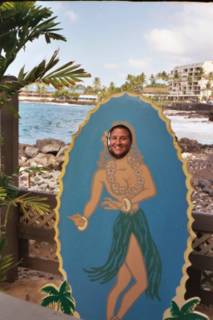
Me at Java on the Rocks, doing the tourist thing

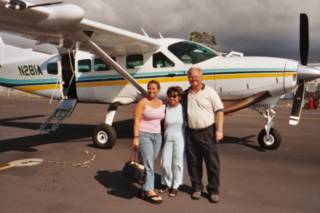
ok, I hate pictures of myself but here's us getting on to the little plane to tour the island


Hawaiian coast

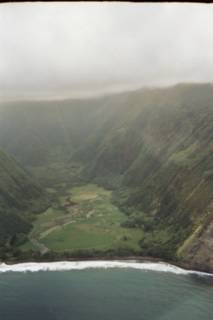
valley from the air

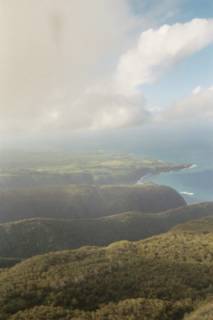
view from the airplane

Friday, November 26, 2004
The last day. How incredibly sad.
We had to check out at 10 am, so we got that done and then we went back over Huggo’s way for breakfast – this time at Java on the Rocks (which becomes Huggo’s on the Rocks for lunch and abuts Huggo’s so it shares that amazing coastal view). I went back to Jack’s Diving Locker for a t-shirt, because overnight I had become totally obsessed with diving and diving culture, and we did some more various and sundry shopping.
That afternoon, we took a tour of the island by plane. Dad was sleeping part of the time, but I thought it was a pretty cool way to see everything. It’s amazing because you literally fly over the entire island in less than two hours. You fly over Kilauea, the big island’s only active volcano at the moment. The lava flows are slow but steady and cover eight miles. Flying over it is sort of unspectacular, in that you don’t go over a mawing crater or see red lava shooting into the air, which is sort of what I was expecting. Mostly, you just see miles and miles of bubbling black stone that covers everything in its path. When it hits the ocean, it cools immediately and breaks into millions of pieces, creating inaccessible black sand beaches that look like black velvet from the air. If you walk too close to the cracks in the lava, you risk plunging into the sea with the rest of the lava cliff. I was happy to be in a plane and not walking.
The interesting part is leaving that barren wasteland and flying past Mauna Loa to the Hilo side. Mauna Loa is a high volcano (is more than 30,000 feet high from the bottom of the sea) but it hasn’t been active in hundreds of thousands of years. That means that the Hilo side of Hawai’i has had time for green jungles to grow over water-carved canyons. That results in the 2,000 feet-high waterfalls you see in all pictures of Hawaii. There’s also the TKTK valley, where thousands of pounds of taro root used to be grown. That was one place I wished we could land and explore. It’s a green valley surrounded by two high walls, and it looks like a place where hobbits would live. (There are pictures of the valley above.)
Today, most of Hawai’i’s agricultural products are macadamia nuts. The sugar industry has moved elsewhere, and the people of Hawai’i no longer live on taro root. There still is quite a bit of coffee grown around Kona, however. We tried to take lots of advantage of that!
The flight ends passing over the Kohala Gold Coast, which is where all those spectacular hotels are, like the Waikoloa Hilton and the Hapuna Prince. Soon we were back at Kona airport and now we had nothing much left to do but eat dinner and fly away home.
I thought this part was going to be really long and hideous, but it wasn’t all that bad. The flight home was much more tolerable than the flight there – I think that’s because you aren’t nearly as excited to come home as you are to get there. In fact, I didn’t want to come home at all. Even as I write this (on Dec. 22, back in Boulder) I feel like I did then, returning to the mainland, wondering when I would ever get to go back to paradise.
The Hawaii Diaries -- Day Seven
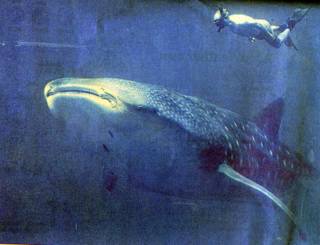
the whale shark

Thursday, November 25, 2004 Thanksgiving
Diving! This was an experience that changed my life. I’ve always wanted to get my SCUBA certification, but for some reason I’ve never done it. It’s not something that just jumps out at you, that you need to learn how to do. One of my goals when I moved to LA was to get certified, but it never happened. It requires coming up with several hundred dollars and I never could justify dedicating that money to getting SCUBA certified. Now I wish I had because I can’t believe I’ve lived this long without being a diver. Had I known, I would have scrapped this whole journalism idea and just cut to the chase and become a dive master on Kona in the first place.
After just taking the Discover SCUBA introductory class, which basically means just swimming aorund in the pool with a mask, tank and regulator, I was totally hooked. Besides wanting to move to Kona and become a dive instructor, I wanted to get open water certified as soon as possible. I was already planning how to budget for it.
Ten people went out on the boat with three dive instructors, plus the captain. I thought I would feel apprehensive at first but I just felt eager to get into the water. I had been so comfortable with the gear in the pool and I already knew what it was going to look like underwater and that all helped. When we finally dropped anchor and got in, I was raring to go.
I have to say, it was all I thought it would be and more. We basically just floated around, looked at fish and coral and rocks and hung out. But it is so much cooler to be breathing under the water just like you belong there. When you are snorkeling you don’t feel as much like you are part of things. When you are diving, you feel sort of lost in that new place, it lets you totally forget real life for a little while. Kind of like being a mermaid for a day.
On the second dive, we actually saw a lot more stuff. We saw a dragon moray eel, which is red and spotted and has two “horns” on his head. He stuck his head out of his hole for a long time and let us all get a really good look at him. Then a sea turtle just came swimming on by, calm as could be. We all went crazy looking at him. I don’t know why because I had just seen several of them two days before, but it’s still cool.
The day before I went diving, a whale shark had shown up in Kona, right off of the snorkel beach. The whole diving community was going nuts about that. They had all gotten on their radios and everyone had gone to check it out. The whale shark is 25 to 50 feet long—the ocean’s biggest fish—and is supposedly very gentle. They have about 300 rows (300!!!) of “tiny hooked teeth in both jaws,” according to West Hawaii Today, the local paper, but they aren’t very aggressive. Anyway, the picture up top is from the paper of that guy. I was kind of disappointed that I didn’t get to see him (and he showed back up on Friday) but I’m not sure what I would have done had I been swimming along and then run into a 25 foot fish. As you can see from the picture, people were just snorkeling right up to him and he really didn’t seem to mind. According to the paper, whale sharks are pretty rare around there. They generally like to live in warmer waters a little further south.
The diving community in Kona – like all communities really – is full of gossip. They had all heard about the woman that had to be rescued by our snorkel boat. I think it freaked people out because it happens so rarely, plus events like that are bad for business. Supposedly she was okay, but still in the hospital. The consensus among the dive masters was that maybe something had happened under water, she had freaked out, come up fast and held her breath, causing over lung expansion. Holding your breath when you dive is the worst thing you can do because then your body can’t regulate to the new atmospheric pressure you face as you go up and down in depth.
After all that diving excitement, the day came to an end way too quickly. We went on in and Mom and Dad picked me up at Jack’s, a newly converted diver.
That night, was Thanksgiving and we went to a Luau. It was something I wanted to do because I’d never done it before but I also thought it was going to be a little bit cheesy. It was a little cheesy, but I think I like that because I’ve enjoyed lots of other cheesy events this year – namely lots of things in Branson. There was tons of food – Hawaiian and otherwise – and I didn’t eat so much of it but it was fun to try it and to learn about it. Poi is as disgusting as everyone says it is by the way. In fact, I thought it was more disgusting the more I considered it, even into the next day. The show also was fun – the performers did dances from all over different island cultures. It’s funny because Hawaii associates itself with places such as New Zealand, Fiji and Samoa, but those places are thousands of miles away. California is actually closer and it’s 2,500 miles away. (There were no dances performed from California.) Hawaii really is the most isolated island chain in the world.
That night I was exhausted! It doesn’t seem like you are doing much when you are diving because you are just floating around basically, but it’s sort of like skiing – it really takes it out of you and you don’t notice until you finally settle down for the day.
Anyway, a most excellent day. So sad to be leaving tomorrow!
Thursday, December 16, 2004
The Hawaii Diaries -- Day Six

Mountain course view


Important shot -- Mom and I both cleared this pond and hit to the green. But we thought Mom's ball hit the lava and bounced into the water. We didn't know it was on the green until we got there. That was a big golf moment.

Wednesday, November 24, 2004
I feel like I am just finally settling in, but I also feel like things are coming to an end. I have no happy feelings surrounding going home. Not that I don't love home, because I do, but home is always there and now I'm in Hawaii! I so wish I could stay for an unlimited time, just freely enjoying myself, and then come back when I feel like it. Unfortunately, vacation doesn’t work this way.
This morning, we actually slept late and went to the little Mauna Loa pool before playing golf that afternoon.
On Sunday, we played the Kona Country Club’s Ocean Course. Today, we played the Mountain Course. I liked the Ocean Course better because it was flatter and more reasonable. The Mountain Course had all sorts of crazy things going on, hills and valleys and wacky carries. Keeping score was pointless. But the views were incredible. That's probably the main thing in golf -- enjoying the outdoors, the walk and the views. If you get too uptight about your swing or your game, all the joy goes out of it unless you are really super good.
After dinner out the last two nights, we ate in tonight. Lots of food to eat so that we don’t have to leave everything to the maids.
Overall, a pretty mellow day, although they are all also action-packed.
I’m going diving tomorrow and I am actually a little apprehensive because getting under all that water has always seemed scary to me. And the woman at the snorkel boat didn’t help.
The Hawaii Diaries -- Day Five (slowly getting there)

Playful dolphins off the snorkel boat


Turtle love at Kapaluu

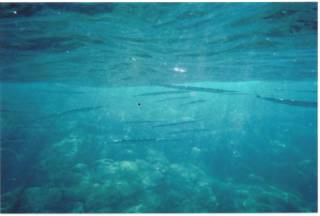
Needle fish

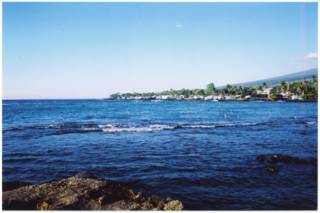
Kapaluu


Afternoon snorkeling at Kapaluu

Tuesday, November 23, 2004
This was the best day so far – snorkel, snorkel, snorkel. Who knew all that cool stuff was under the water? I guess I did know, but you don’t really think about it much until you are checking it out.
In the morning, we went out on the Pacific Dream Cruise. (I don't know that it was such a dream, but it was only $39 for all three of us because of our timeshare discount.) When we got there, it was only the three of us and one other guy on a sort of old beat up trimaran that could have held 50 people! Word was that an ocean liner that was supposed to have come in didn't, so business was slow. All the better for us, and we embarked on our essentially private cruise. We had a crew of three to our four, with Captain Kahani (pronounced Connie), First Mate Jordan and crew woman Astrid.
Kahani was just a little guy, but he was competent. I wondered right off why his tatoos were being removed and why he had taken out all five of his earrings, of which only the holes remained in his right ear. Given that observation, Mom later learned that his goal was to become a captain of a private yacht for $100,000 a year or so, but his tattoos were hindering him, so he was spending some $10,000 to get them removed.
Jordan, who was perhaps the most tan person I had ever seen, was a single mom but she was dating a guy who came from Leadville, Colorado. We didn’t learn that much about Astrid, other than that she was young and blonde and came from Hilo.
Chatting with Dutch, the other guy on the cruise, I learned he hailed from Holland, hence his name. His real name was Arthur and he didn’t really speak Dutch any longer. He was attractive, in his late 50s. I learned that he was actually half-owner of the company that owned Pacific Dream Cruises (or so he said) and had shown up on a secret scouting mission. He told me not to tell anyone, so I didn’t, although I pondered warning the crew. He wasn’t that happy with the state of the boat, which was 30 years old and needed painting.
The night before had been rainy and storms were predicted all day long. The morning opened cloudy and a bit cool, but rain didn’t seem imminent. The stormy weather from the night before had made the water a little rough, so we had to search for a place where we could moor up. After checking out one harbor, we went to another. Captain Kahani decided it was too rough there as well, but we did see a pod of spinner dolphins and that was so cool. They just swim up to the boats, check them out and hang out a little. They really are so social and seem to enjoy saying hi and swimming along with you for a bit. I wished we could get out and swim with them.
We ended up going back to the first harbor and tying up. Now it was time to jump in, a prospect I hadn’t really given much consideration to. The only time I had ever snorkeled before was at a snorkel park around Playa del Carmen and that was pretty easy peasy – like snorkeling for retards in a super giant manmade aquarium – awesome, but not really occuring in nature.
Still, I strapped on my mask, snorkel and fins and jumped into the water. Looking down, it was pretty much a watery wonderland – with all sorts of colorful fish swimming around. Jacks, also known as Chubs, hovered near the boat like stray dogs, hoping for some cast-off food (which they got, by the way). There were surgeon fish – deep black with a few marked white stripes – an irridescent blue-green fish the Hawaiian name of which I can’t remember. I saw one parrot fish way down there, and also a moray eel at one point. Lots of bright yellow fish, black and yellow and white angler fish with a big fin hanging over their snouts. It was cool to see all the life just there beneath the waves, something you never consider but that is always going on.
We snorkeled, ate lunch (hamburgers and hot dogs and grilled pineapple – the water slide didn’t work to Dutch’s sort-of secret dismay but the gas grill did) and then Mom and I got in for some more snorkeling. When I first got in, I looked below me to see a squadron of divers about 25 feet down, which was kind of cool to see. I was going diving on Thursday and it was fun to check out what they were doing.
Finally, I moved on, swimming and floating about the cove. I was out there for a long time, but everyone on the boat seemed relaxed and not worried about me so I just kept swimming. At one point, I looked up and everyone was standing on one side of the boat peering out and I knew they were seeing something cool that I was missing, but I couldn’t get back in time to see it. Turns out that was a whale and I was mad I missed it.
Anyway, I was still snorkeing away, absorbed in my own little world, when I saw a lot of commotion at the boat. I started swimming back and I heard a woman screaming in a very frenzied voice: “help her, help her, help my sister!”
At that point, I decided I had better get back in case they needed help or just needed to get on our way. When I got back, everyone was working hard to pull up a scuba diver, who seemed to be passed out because they were having a tough time getting her up. I wondered if the woman was breathing because you could tell she wasn’t awake. But things were chaotic and I just waited to get the information later.
Turns out, something had malfunctioned with her tank and she had inhaled a lot of water. After that, she panicked and grabbed her sister’s regulator but that didn’t help. She came up fast, never a great thing, and was disoriented and choking when she got to the surface. She just so happened to surface right at our boat, which was lucky (or providential, as my Dad said) for her, because she needed immediate help. She was alert enough to ask, but she passed out fairly quickly and started turning blue, according to Mom and Dad.
They got her up on the boat and on her left side so she could lay and let the bubbles, which happen when you surface too quickly, pass out of her system. She threw up a lot of salt water, but finally she was awake and breathing again. Very shaken, but likely okay. One boat, from Jack’s Diving Locker, took her and her husband back to shore because that boat’s divers weren’t in the water yet and it was a faster boat than our 30-year-old catamaran. Her boat, Kona Honu Divers, got all their people back on board before finally taking off.
Ultimately, everyone was okay, but it was both exciting and somewhat traumatic. Mom didn’t want me to stick with my plans to go diving on Thursday, but I was resolute because I had always wanted to try scuba diving and the chance doesn’t come up that often. Dad and I agreed that using the law of statistics – the “lightening strikes” rule, I like to call it – I was unlikely to run into trouble.
After that, we cleaned up and went on in. Dutch never told them who he was, but even though he said he was unhappy with the condition of the boat, he had to be impressed by the way Captain Kahani and the crew handled the emergency because Kahani stayed calm and in charge the whole way.
I so loved snorkeling that mom agreed to go with me to Kapaluu, the nearby snorkel beach, in the afternoon. Kapaluu is like one really really big aquarium and you can swim forever without it ever getting too deep. Actually, I wish I had spent more time there while we were in Kona.
Some of the pictures above are from Kapaluu, including the turtles, which is my favorite picture from the whole trip. It was so cool to just be snorkeling along and then run smack into these two turtles. (I was actually given a tip by a fellow snorkeler, but Mom and Dad both saw turtles here no problem.)
After snorkeling, Mom and I indulged in Mai Tais and I have to say, those babies are strong!
For dinner, we went back to Huggo’s. The meal was great, but the coolest part was looking over the balcony into the cove. We could see a moray eel (which Mom called "the creature," and we got sort of obsessed with watching it) sliding from tidal pool to tidal pool, hunting, and there were also herds of crabs (my own biological term), scuttling sideways along the rocks.
Monday, December 06, 2004
The Hawaii Diaries - Day Four (hooray! the pictures are here!)
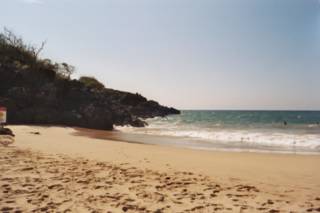
Hapuna State Beach


I don't know where I took this, maybe at the Hilton, but I think it's a really cool picture.


The pool at the Waikoloa Hilton


Mom and Dad on the bridge over the pool at the Hilton


Mom and Dad at Huggo's later that night

Monday, November 22
Unfortunately, two days have gone by before I’ve had a moment to sit down and write this so my memory of this day is not as fresh as it otherwise would have been. So, what did we do on Monday? Hmmm….
Oh, part of my memory blockage results from the fact that on this morning we finally went to the time share presentation. The presentation, given by a guy named Mike Ireland, was actually interesting, it’s just when we get into the closing and Dad gives his objections, that the whole thing gets unpleasant. Dad, a former salesman, loves to argue and somehow still believes that he can convince people of his way of thinking. It’s my opinion that the more you argue, the less chance you have to convince anyone of anything because they just get more angry and more stubborn. Let me add that this view doesn't mean I don't argue -- oh no, I do. And my efforts are to as little avail as anyone else's.
So we started down that process, but it came to a fairly abrupt end because I got annoyed feeling that Dad was being rude. Also, Mike just wrapped it up because I don’t think he really wanted to argue that much either. Dad also told Mike up front that we were just here for the discount so I think Mike didn’t feel that inclined to push.
In any case, once the whole time share thing and discounts were taken care of, things were much more relaxed. Our plans were finally … finally! … made and now we could just relax and enjoy.
That afternoon we drove a fairly long way to go to a big sandy beach with actual waves. Although I didn’t really like the drive (didn’t want to be in a car at all at any time), it was a cool thing to do because we got to see more of the island, which is actually a pretty barren place, mostly covered in black lava and shrubbery, with an occasional resort of golf course thrown in here or there. Besides checking out that beach – at the Hapuna State Beach Resort – we also saw a bit of the hotel there, the Hapuna Prince. Supposedly that hotel also has a golf course, although we didn’t see it. I wouldn’t want to be up at that part of the island because it’s pretty remote. Down where we are, we have great access to Kailua-Kona, which is an actual town, and I like having that.
That day we also checked out the Waikoloa Hilton, which is like the Disneyland of hotels. It’s huge, and a boat or a lightrail takes you from the initial lobby over to the mammoth pool. At the pool, which of course sits next to the rocky coastline, there’s a waterfall, waterslide and hanging rope bridge. It’s all quite elaborate. We were going to get a drink there, but the bartender was overwhelmed with making frozen drinks for thirsty and demanding tourists (such as ourselves) and Dad got impatient so we departed. Patience is not a virtue any of us possess, although I’m sure each one of us is convinced that we ourselves are much more patient than any of the others.
In any case, we got back into the Chevy Impala rent-a-car and headed back to our place. That night, we actually got cleaned up and went out to dinner at a place in K-K called Michelangelo’s. We went because we had a card to get a 20% discount on food and the restaurant was on the coastline. So we had italian food (Dad Italian sausage and peppers, Mom chicken parm, me spaghetti and meatballs) and it was lovely and actually quite a deal.
We then went to a place called Huggo’s for drinks, which also is right on the water. Huggo’s seemed like quite the place to be, although Dad didn’t like the music much (slow and piano bar-ish) and Mom had wanted to dance and that wasn’t happening. So we had yet another drink and then went home. (Too many drinks for Paige, Dad enjoyed pointing out.) We didn’t stick around Huggo’s that long, but the menu looked great and the setting was amazing so we resolved to come back another night.
The Hawaii Diaries - Day Three

swimming at the Sheraton

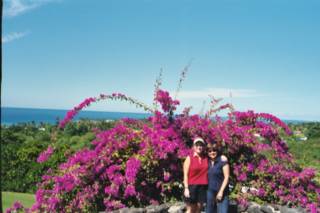
Just before the 19th hole

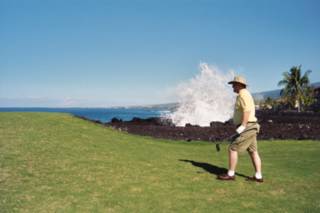
waves splashing on the beach while Dad walks to the tee


Kona Ocean course

Sunday, November 21, 2004
This day started early. We had a 7 am tee time, which required checking in at 6:40 am. What was I thinking when I said I was willing to play golf early? I can’t even speak at this hour, much less hit a golf ball. But at least it would be quiet and still outside, and not so hot. Plus, we would get done early and be able to spend the rest of the day at the beach or the fabulous Sheraton pool.
Turns out, none of us slept well in anticipation of the early tee time. But once I got to the golf course, which was unbelievably beautiful and luxurious, I didn’t really care what time it was. The fairways were like carpets and the greens were fast and perfect; there were scarcely even any bare patches on them. Several holes butted up against the black lava coast line; in some cases, we had to hit over frozen bubbling lava. On hole seven, waves splashed up next to the tee box, spraying you a bit during your back swing.
Again, I’m really not a good golfer, but I had a great time. I could have gone in after 18, eaten lunch and come back out and played another 18. I took out my driver and hit plenty of good drives with it, only needing a mulligan one or two times. I cleared the lava no problem on the one hole where I had to get over some stuff. And very best of all, I chipped it in from about 25 yards on the 18th hole. What a way to finish up!
After lunch, Mom and I went over to the beautiful Sheraton pool and just hung out, while Dad stayed at the unit and took a nap. I think besides usually being tired, the jet lag has been hard for him to overcome, but he woke up from his nap quite perky.
I made dinner that night – salmon with mango salsa and broiled t-bone steak with rosemary and salsa fresca. Roasted green beans and potatoes and Hawaiian sweet bread rolls (which taste like Gramma A’s bread—for those of us who have had it—only maybe a little moister and softer. Very yummy.) Hawaiian coconut ice cream with chocolate syrup for dessert. That was delicious too, although the coconut ice cream didn’t really taste like the coconutty things we are used to on the mainland.
We talked about going out to the Kona Brew Pub to hear some music, but ended up staying in to watch Desperate Housewives. I have to say, TV fan that I am, it was worth staying in for. Thoroughly enjoyable. I could complain right now that vacationing with the parents makes one a homebody, but frankly, I think I’m the one that wants to stay home. They seem more than willing to go out, but I so love to cook, and I figure it saves money, that I’m just as happy being here once the sun goes down. That doesn’t speak well for any potential social life I might ever have again, but I think once you get past a certain age, you would rather get up, get out and get back. I’d rather spend my days being active and my nights at home, than my nights out and my days sleeping. I do sort of miss my party days, but this way is probably healthier.
After dinner, I took a not-so-hot tub (not cold either, but it could have been a little hotter) in the tub next to our unit. That was a relaxing thing to do right before bed, plus the Hawaiian sky was amazing. Big clear stars and a bright moon in a partly cloudy sky. I looked up and saw a genie riding on a magic carpet in the clouds. I looked down and saw my skin covered with silver beads as the hot tub jets shut off. I breathed in the alone time and thought about my life, about which I am often prone to anxiety. And I felt fully aware of the true value of being in the present moment and absolutely nowhere else.